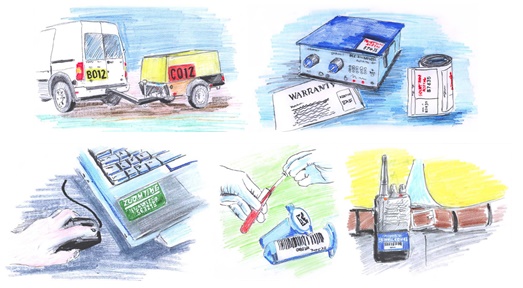
Before we get started, what is asset tagging, and what are asset tags? Broadly speaking, an asset tag is any label used to identify one's property (or 'assets'). Most asset labels feature a unique serial number or barcode that can be used to distinguish the labelled object from other, similar-looking items.

Asset tagging is frequently used by businesses and other organisations as a loss prevention measure. High-value items such as computers, tools, and electrical appliances will each be assigned a unique serial number (or barcode) and marked accordingly using some sort of label or tag. Additionally, it is quite common for a business to print their name and/or logo on their asset labels for extra ease of identification.
Why It’s Important to Tag Your Assets?
Asset tags help to minimise the risk that property will be lost or stolen in a number of different ways. Firstly, they can be used to compile a detailed database of one's assets. This means that when a labelled item goes missing, the owner can refer to their database and say, for example, that 'laptop #101158 is missing' rather than simply 'one of our laptops is missing'.
Benefits of Asset Tagging
The benefits of asset tagging, however, go further than just the identification of a specific item. If the database is properly managed, the owner may then be able to get a little more information regarding the lost object's last known whereabouts. For instance, a university library that loans out electrical equipment would be able to identify the last person who borrowed the item in question.
If the owner suspects their property has been stolen, they can quote the lost item's unique serial number when reporting the crime to the police. Asset tags make stolen goods identifiable; not only does this mean that labelled items are easier to track down, it also means that thieves are less likely to target your assets in the first place. Asset tags are a great deterrent!
Types of Asset Tags
A savvy thief may attempt to peel off an asset label in order to conceal their crime, but there are other types of asset tagging systems available for this exact reason.
High-security labelling solutions such as destructible asset labels and tamper-evident asset tags make this tactic unviable.
Destructible asset labels are a form of asset marking that are made of tamper-proof cast PVC vinyl. If you try to peel one of these labels off, the label itself will fragment, preventing it from being peeled off the item.
Tamper-evident asset tags, on the other hand, will leave behind a permanently printed pattern if removed. This means that even if this asset marking is removed, an imprint of the label will remain. Furthermore, it will be clear if someone has removed the label and then tried to reapply it, as the two parts of the label cannot be removed intact.
How Durable are Asset Tags and Labels?
Our asset tagging and tool tagging materials are created with durability in mind. Each type of asset tag is made from a different material depending on its purpose, so you can invest in the asset tagging systems that will be most suited to why, where, and when you need them.
Many of them are made from vinyl, making them suited to outdoor items if required, whereas we also have polyester asset tags for items in areas with higher temperatures.
Tagging Assets with Label Source
Click here to browse Label Source's full range of asset tags and labels, or contact us if you would like us to produce custom asset tags for your organisation.